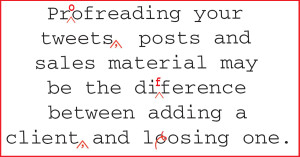I received an email recently from a woman that I follow on LinkedIn. The subject line made me want to open it: “Watch my interview …”
So I did. But, the first sentence caused me to stop reading.
Why?
I stumbled across two grammatical errors in the first sentence alone. I immediately went from being interested in her interview to feeling like I had been marketed to by a fifth-grader (with poor grammar and proofreading skills).
In an age where text messaging makes it okay to abbreviate and in some case misspell words, it has become easy to fall into the trap of not giving our professional writing a thorough enough review.
I would argue that not rechecking your writing and editing the mistakes is like offering a product or service for your business, but asking your customers not to buy it. Your authority is diminished because of inaccuracies. Potential customers may wonder if they can trust you.
In short, proofreading matters, folks.

Missing a word or using the wrong “your” is certainly not the end of the world – or the end of your business. It could mean the difference between making a sale or adding a client or losing business to a competitor who takes the time to thoroughly proofread and ensure proper messaging.
To bring an added level of professionalism, consider following these reviewing techniques anytime you write.
- Read aloud
Sometimes “hearing” how writing sounds makes it easier to find mistakes than simply reading it on a page or computer screen. It also makes it easier to find natural breaks to determine where punctuation should be added. Reading silently is also an important step in the proofreading process.
- Review multiple times
Read once for content and to be sure everything makes sense. It is also best to re-read additional times to check grammar, spelling and punctuation mistakes.
- Fact check
Be sure to double-check the accuracy of important dates and special offers. You will want to ensure that all of the details about an upcoming sale match across the Web, on fliers and social media, for instance. Triple-check headings, content in separate columns and any pricing or math-related text.
- Ask for help
Have someone else who is familiar with your small business proofread the content for clarity and accuracy. Have your proofreader answer these questions: Does it make sense? Has any information been omitted? Is the content interesting? Is everything correct? Track Changes in Microsoft Word are helpful to see not only what is incorrect, but also the reviewer’s comments and suggestions to fix it.
- Use spellcheck
The spelling and grammar check on Microsoft Word is a good last ditch proofreading effort. It will not correct which version of “your” and “you’re” should be used and it will not know if a special offer, as outlined, is correct. It is a helpful tool mainly to check spelling and should not be used in place of thoroughly and carefully re-reading.
For more helpful proofreading tips for your small business, call Theresa Katalinas at 215-519-8833 or email katalinascommunications@gmail.com.


